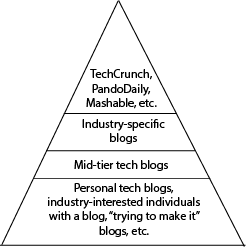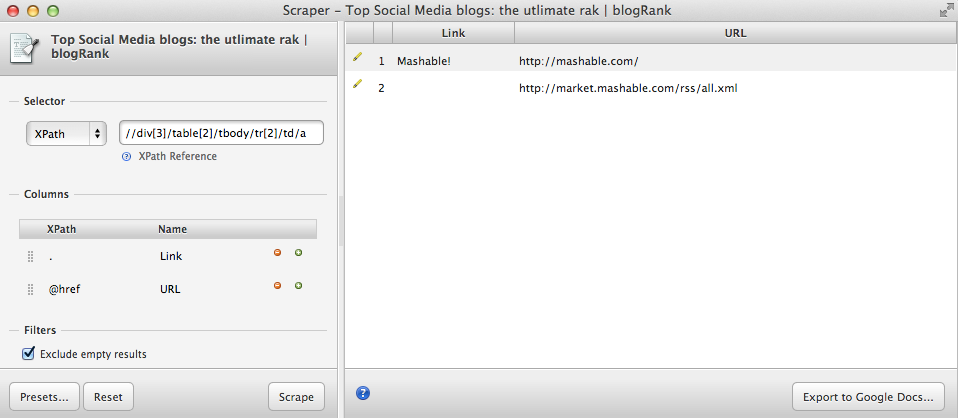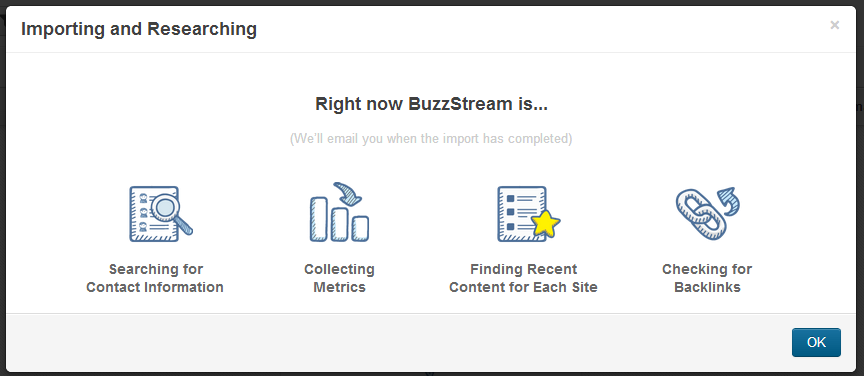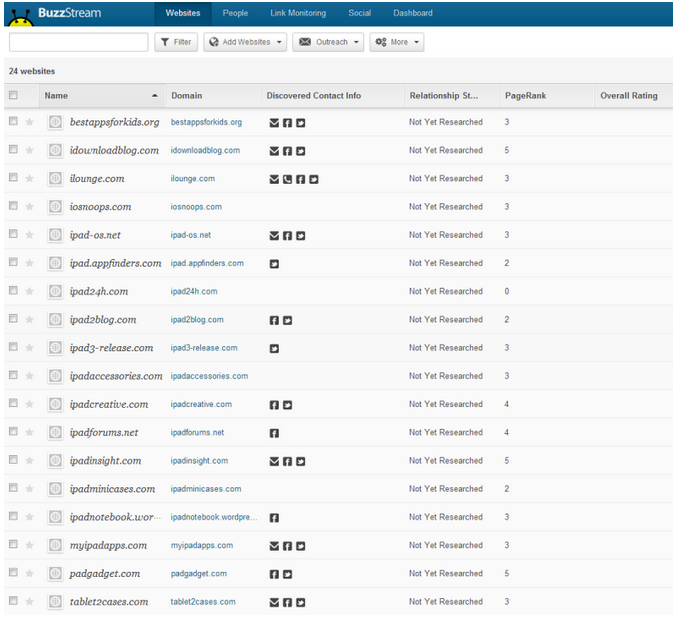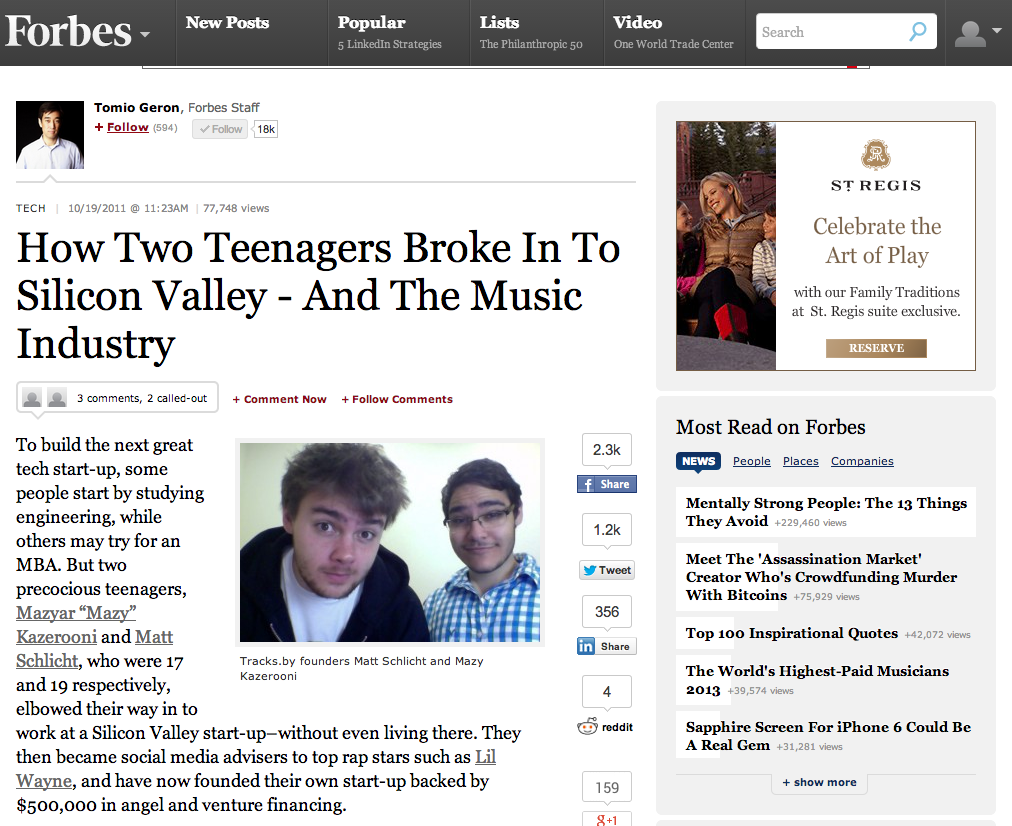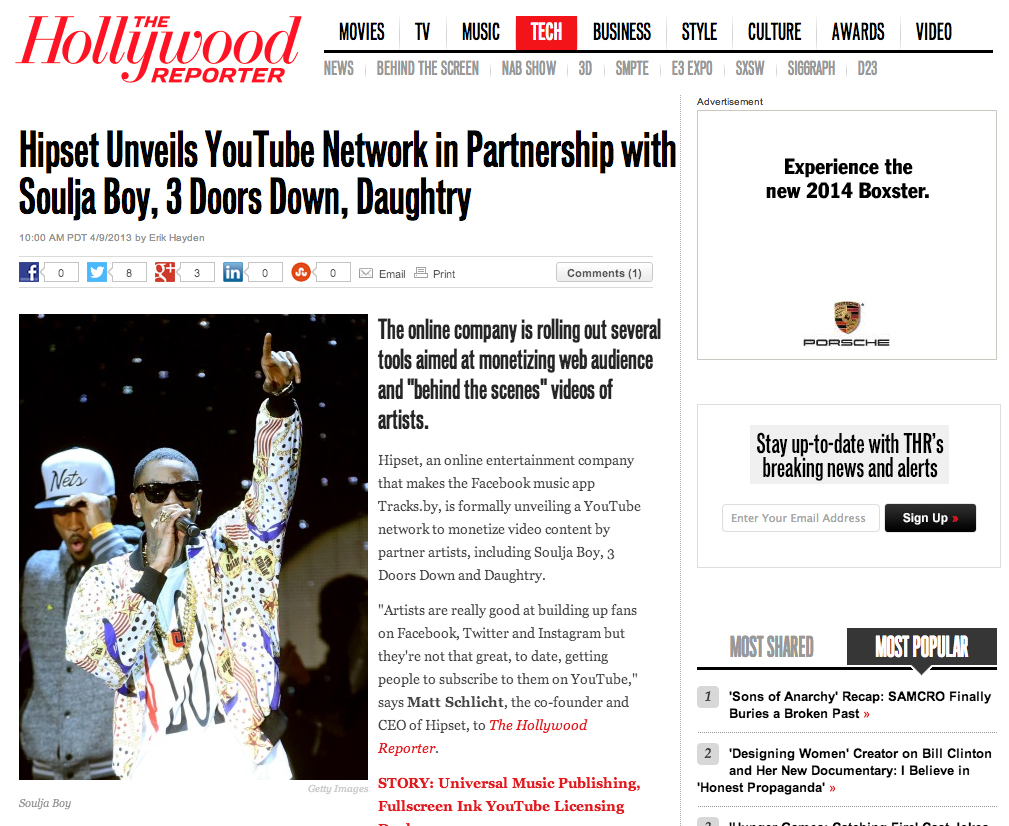How to get press
How to get press
How to Get Press
by Jarrett Streebin
We’ve been working with a PR firm for a while now and we get a lot of questions about how to do PR. While this isn’t a comprehensive guide, it’s a good starting point for getting your startup in the press.
Goals
Before you do anything, you should define your goals for PR. Are you looking for more users or customers? Help with recruiting? Investor interest? Each of these have different PR strategies that work best, so it’s important to clearly outline what you hope to achieve from PR.
If your goal is users, for a consumer app or site, a great place to start is Hacker News or reddit. These are combed by early adopters and if there’s promise for your product, it will likely take off there.
Another great place to launch apps is on blogs. I don’t follow these much anymore, but sites like AppGratis or other app-a-day sites used to be good places for distribution to early adopters.
Whether it’s an attempt to gain users, customers, or investors, these all likely start at the same place: reaching out to journalists or bloggers.
Getting Started
Now that you know your goals, start reading relevant media. An important piece of effective PR is knowing a publication’s work as well as its style. This will give you an idea how companies are presented so you can better tailor your own pitch for success. It will also expose you to other companies that are getting press and what’s being written about them.
For example, TechCrunch is great for fundraising, big product updates, and major milestones. Knowing this means I won’t try to pitch them on featuring my app or site with no traction or funding. Fortunately, there are sites that are great for this, TechCrunch just isn’t one of them.
By doing this you’ll be able to create a list or relevant publications. From there, start keeping track of reporters or bloggers that cover relevant startups or ideas.
Once you’ve got a list or reporters, you’re almost ready. One important tip is to start small. Want to be on the NYT someday? Don’t start there. PR is very much like sales, you want to gradually build up to bigger publications. Going straight after the top of the market isn’t going to work, and could harm your chances with them in the future.
Start on industry blogs or sites. They will not only be easier to reach, but they will also provide great practice to get you ready for the bigger publications.
Although it doesn’t sound important, practice is crucial for success in PR. Those early, smaller interviews are great for improving your pitch as well as minimizing the impact of any mistakes you may make. I’ll provide more practice tips below, but here’s a great example of a PR mistake I made.
Early on in our PR efforts I was speaking to a blog you’ve probably never heard of. We hadn’t yet announced fundraising, but I mentioned on the call that we had raised money. Within an hour this post was live. A post on an unknown tech blog was not exactly what we had in mind for our fundraising announcement.
Fortunately, no one noticed and it was a free lesson about what not to say to reporters. More tips on that below.
Storytelling/Message Development
Before you reach out, you need to know what story you’re telling. The quality of your story will determine whether or not you capture a reporter’s interest or end up on the cutting room floor.
Ask yourself questions like these and try to distill what it is that’s exciting about your product or company. Without strong storytelling, it’s unlikely you’ll get past the first step of getting interest from a reporter.
How to Reach Out
I recommend starting with the most junior reporter or blogger at the publication you’re interested in. Also, only hit one reporter at a time from each publication.
Additionally, it’s important to note that this outreach isn’t about writing a piece, it’s about connecting with them and establishing a rapport. What we’re going for is to learn about the reporter and teach them about your company. An informed and interested reporter will lead to much better coverage long term.
This also means you should reach out far in advance of wanting press. If you think you’ll want to do some PR in a few months, reach out now.
Here’s the method I use today and have had excellent results:
Subject: Great Article About
I really enjoyed your article about
I’m the CEO and Founder of
Have time for a quick call? // Can also offer coffee, if they’re local. Just so long as it’s a question.
By complimenting, you’re showing you’re familiar with their work and aren’t just looking for a quick piece of press. And by showing you’re knowledgeable on the topic, you’re offering to be a valuable source in future work.
Here’s an actual email that worked, with name and topic redacted:
Subject: Love Your
Great piece on
I’m the Founder and CEO of EasyPost, which is a shipping API for all the major carriers. We ship millions of packages a month for companies like Shapeways, Teespring, Groupon, and others. Our investors include Peter Thiel, Ashton Kutcher, Y Combinator, Google Ventures, and more.
We’ve seen a big shift on the customer side as well for the holidays. Instead of relying on the standard delivery dates, they’re using the actual cutoffs provided by the carriers. We also see customers setting up pop up distribution centers for just the holidays.
I’d love to talk if you have time for a quick call.
The reporter responded the next day and we had a call.
Timing is an important aspect as well, since the most popular time for press releases and product launches, at least within tech, is Tuesday. Given that, you’ll have better luck emailing them off-peak. Try later in the week and in the afternoon.
Rinse and Repeat
If the reporter didn’t respond, ping them again after one week with something like this:
I just wanted to follow up on my earlier email. Let me know if you have time for a quick call.
Also, when you send that one, send a note off to the next reporter on your list from that publication. Remember, just like with sales, it’s a numbers game. Make a list of potential contacts, email them one by one, and follow up.
It Worked, Now What?
Once the reporter responds, I like to do something that salespeople call mirroring and matching. If they respond in an hour, I respond an hour later. The point with this is to match their interest and not to seem desperate.
After that, respond with something agreeable in terms of scheduling. Let them know you’re flexible, but toss out a distinct time. Something like this:
Thanks for the note. I’m free Monday and Tuesday. How’s Tuesday at 3pm ET?
Also, I usually don’t propose the day of. You’re important, you’ve got things to do. You’re also not desperate to get on the phone. That is, unless they propose it, then go for it.
What Not to Say
The first rule of PR is do not say anything you don’t want printed.
The second rule of PR is DO NOT SAY ANYTHING YOU DON’T WANT PRINTED.
It’s that important. In my example above, I showed how important this is.
But what about ‘off the record’? Roger Ailes says you should never say anything off the record. If you’ve known the reporter for years and have a rapport, that’s one thing. But in the case of a reporter you’re just meeting, keep it on the record by not saying anything you don’t want printed.
Additionally, don’t ask for coverage. The point of this outreach is to meet the reporter and establish a rapport. Coverage comes later.
What to Say
Ask questions. I know, I know, you’re reaching out to talk about your company. But this isn’t about you, it’s about the reporter. So ask them questions. Have a list of these before the call.
What do you think of
I really enjoyed your reporting on
A good reporter will typically guide the conversation with their questions, and the more the merrier. But having your own questions is a good way to get to know them, show an interest, and learn other areas where you might provide value to them.
For some of their bigger questions about product or traction, you should shoot for a few glowing, 30 second bits about the following:
Problem: what it is you’re solving
Customer: who is the target customer, or actual customer if you have them
Traction: what have you done to date
Market: how the market is
BIG: how your idea gets to be big
Team: how great your team is
This is the same strategy we used for our successful Y Combinator Interview and it works for almost any type of interview or selling scenario.
You don’t have to do all six, preferably not, but 2-4 of them is good. They can often be said in response to questions the reporter may have. (ie How big is this market? How big of a problem is this?)
Practice
These tips are helpful, but the important thing to do is to practice. Write up a list of questions they could ask and run through your answers.
If you’re going to be doing face-to-face interviews, you might as well practice with the camera on your phone or laptop. This will show you how you look to a reporter.
Also, if you want some tips from an expert, Roger Ailes has a great book called You Are the Message about how to effectively present yourself.
How to Actually Get Press
Now that you’ve established rapports with a handful of reporters, you’re in a much better position to be written about. Often, if you establish a strong rapport, the reporter will ask about any upcoming announcements you might have. That’s when you can mention upcoming product announcements or milestones. If that’s not the case, don’t worry, you can still pitch them on your news.
As a general rule, the bigger the publication the longer it takes to be written about. For smaller or tech-focused publications, sometimes one call is all it takes. For bigger ones, it can take a few months and several contacts.
Ideally, you’ve made contact with these reporters in advance of wanting press, and so some time has passed since you first contacted them. Say, at least 3-4 weeks.
Figure out what you want to publicize. Is it the fact you’re growing at an incredible rate? Have you just launched a new product? Recently raised some money? For tech PR, these are all standard things to announce.
Reach out to your reporter of choice, only one, with something like this:
Great chatting with you
We’re launching
I’d love to give you an exclusive on this announcement if you’re interested. Do you have time for a quick call?
Give them at least a day or two. If they don’t respond, move on to the next one, but never email two at the same time offering an exclusive.
Scaling Your PR
Once you’re ready to scale your PR efforts, hiring a PR shop can really help. PR shops are great for once you’re doing or wanting to do more press than you can manage. They’re also great if you’re just starting and don’t want to do all this work, or don’t know how.
The approach we used is to look for companies that have PR you admire. Are they always doing cool press launches? Do they seem to have an in with important reporters? Reach out to them directly and ask who they use for PR. As long as they’re not a competitor, the company will likely tell you because it sends business to their PR shop, which makes them look good.
And since you’ve been practicing and getting articles of your own, you’ll have a good idea how to pitch your story and what you’re looking for. You’ll also be able to jump right in with your own existing contacts.
How to get press
Getting press coverage is one of the most effective game marketing methods for launching your app or game. However, it can also be a challenge for indie developers. In this article, we’ll show you how to easily get press and the best strategies to use to help you market your indie game like a Pro.
Let’s jump right in …
Game Marketing 101: Start with a Great Game
Before you start finding press contacts to pitch to, you have to make sure your game is great. A game that is just okay or below average will not gain any coverage. For your game to get press coverage, it has to be good. Make sure your game is polished. It should have high-quality graphics, unique gameplay features and be free from any bugs or errors. Double check to ensure it’s up to standard. Look closely at every aspect of your game. Search for any areas that you could improve on. Maybe the graphics could be better, or it lacks the right sound effects. Seek out minor and major weak spots and make the necessary changes to improve it.
To help you pinpoint with accuracy where your game stands use beta testers. When you use beta testers, you’ll be able to get the most honest feedback, which is essential if you want a well-polished game. Your game has to be ready when you present it to journalists, bloggers, and reviewers. So, always check to make sure you’re pitching the best possible version of your app.
Find Your USP / Hook
Once you have a great game, you need to find your app’s USP (Unique Selling Point) or hook. Your USP or hook is what you’ll use when you’re reaching out to press. It’s your secret weapon. Think about what makes your game stand out from the crowd. Ask yourself, ‘What makes my game special?’ Take some time to analyze your game. Sit down and play it again. Then take out a sheet of paper and begin to brainstorm a list of all of the features that make your game special or unique. Try to come up with as many things as you possibly can. You can have a tester, friend, or family member also do the same for additional input.
Examine your list. Select the best USPs you see. Choose a variety of hooks from your list. The goal is to have hooks that showcase your game’s gameplay which will impress game journalists and reviewers and hooks that feature a ‘bloggable’ factor that any general blogger or reporter would find interesting. It’s good to have both of these types of USPs in your game marketing arsenal when you start reaching out to journalists.
Build Your Press Kit
The next step is to make your press kit. In game marketing, press kits also known as media kits include all of the promotional material and information related to your app or game. It’s usually compiled together in a downloadable file or located on a particular page on your website. To market your indie game, you need a press kit ready that’s readily available. Press kits are time-savers that make it effortless for journalists and bloggers to learn more about your app. Don’t expect success. Prepare for it. If you want to succeed in gaining press coverage, you need to have one in place.
Your press kit should include a demo video or gameplay trailer, high-quality screenshots, icons, banners or logos if any, and a press release or document providing general details about your app or game studio.
Create a Trailer / Demo Video
Every good press kit should have a gameplay trailer or demo video. In game marketing, videos are one of the most efficient visual tools to use. They help to captivate press and to win over potential players.
A good game trailer should instantly grab the viewer’s attention to excite, entertain, and explain. You only have the first 20 seconds of your trailer to captivate your audience. Don’t waste valuable time showing the start screen, your logos or with a long intro. Try to dive right in with highlighting your gameplay and hook. If it’s possible to show everything your game is about in a single shot go for it. The goal is to get their full attention and get them pumped about your game.
Be sure to highlight your USPs or hooks throughout the trailer. Your unique gameplay and or features is how you stand out in the crowd. Edit different segments of your gameplay with a soundtrack that sets the tone of the game and creates the perfect mood. Audiojungle.net is a good place to find music and sounds for your game. Trailers are all about showing people how cool your game is.
Include High-Quality Images
Your press kit should include a variety of different high-quality images to promote your app. It’s important to have these types of images available, so your game will be represented in the best possible way. You don’t want journalists to be forced to use Google to find your game’s screenshots or your studio’s logo. What comes up in the search may not be the best depiction of your app or company. Always have at least 3-5 good-looking screenshots that highlight the best features of your gameplay. Add icon images sized for each platform that your game is available on as well. Additional images like banners, your studio’s logo, and your profile image are good to have too.
How to Write a Press Release
Your press release is a major part of your marketing strategy. Knowing how to structure it and what to include is important. Try to create two different versions, one in a PDF that includes images to add to your press kit and another in a plain-text form that you can use and quickly reference when needed for emails.
Below is a quick rundown of the standard Press Release structure for an App (PDF version):
When you’re writing your press release there a few things that you have to keep in mind. The first is remember that your press release is not an advertisement. They are announcements. So try not to exaggerate and appear gimmicky in your release. Focus on your unique selling points and the facts about your game. Also, remember that all press releases must be written in a third-person perspective. Avoid using the term ‘I.’
Take out your list of USPs and hooks and use them as a guide when you’re writing your press release. Your app summary line should answer these two question simultaneously, “What type of game it is?” And “What is the app’s unique feature?” In the introduction section, you explain this further summarizing in 2-3 sentences what your game is all about. And finally, in the description section, you discuss the game’s features and reiterate the hook. Remember to only include images in your PDF version for your press kit. In the text version follow the same format but leave out any snapshots. Although it’s recommended to have a press release in your kit you can also choose to just have a simple word document with all of your game and studio’s information as well.
Pulling it All Together
Now that you’ve got a press release, game trailer, and all of your images it’s time to decide how you’re going to pull it all together. If you prefer to have it available at the bottom of your app’s website as a downloadable link, you can convert the files. Then if necessary, using a hosting service embed it into your site. You can also choose to have your press kit on display visually. There are tons of different styles of press kit templates that you can download for free or buy to integrate into your website. Search and find a layout that fits your game or studio’s style or hire an outsourcer to create one for you. If you have difficulty adding your press kit to your website you can enlist the help of someone for that also.
How to Get Press Coverage
When you have your press kit complete, you’re ready to start marketing your game. The first step is to figure out who to reach out to. To do this, you’ll have to conduct some research. Go to the same platform your game is on and find similar apps to your that are doing well on the charts and make a list. Then go through each game and research to find out which sites have covered it.
Go to Google and click on the ‘Google News’ tab. Then type in the search box the name of the game that you’re researching. Every site that has mentioned the game will come up. Check it out to see if getting a write-up from that news source would benefit your game. If so, find the journalist that wrote the article and write down their details. All of the names that you find during this process should be added to your official press list.
Create your press list in Excel or a Google Spreadsheet. Designate columns to record the company, journalist’s name, website, Twitter profile link, email, author page or link, additional contact, role, and type of media. It’s a lot of work, but it’s worth it once you have a functioning list. You can also categorize your list by types so all the gaming journalists are in one group and all of the YouTubers or Bloggers are in another. How you organize it is entirely up to you, as long as you record the necessary details.
Emailing Press
Take the time to go through your press list and further research each journalist. Reading several of their other articles can help you better determine whether or not to reach out and pitch your game to them. If they don’t seem to be into your app niche, then remove them from your list. Also, try to follow the journalists that you’re interested in pitching your game to on Twitter. Your odds of getting press coverage can increase when you establish relationships and connect.
When you’re emailing press, make each email pitch unique and personal. Avoid just copying and pasting a generic template. Instead, address the journalists by their name in the email, reference the previous articles they’ve written to signify you’ve done your research and have a great newsworthy game to pitch. Write your email subject heading like you would a news article title. Use your press release as a guide. Don’t forget to work in your game’s hook. It’s an effective marketing strategy. Keep your email short and include links to your game and press kit page.
For press coverage, send emails at optimal times according to the writer’s timezone. You can make a note of it on your press list. Remember the best times to send email is early in the week during morning hours. Tuesday through Thursday are the best days of the week to reach out to journalists.
Promoting Your Indie Game like a Pro
Research and find journalists or bloggers that you can contact to help you get the word out about your game. Connect with them and establish a relationship. Follow them on Twitter, read their articles and when you’re ready to reach out to press, send them an email pitch. The results might surprise you. Getting media coverage is just one of the many strategies you can do to get your game noticed. When you’re promoting your indie game, try to start early, make a plan and stay consistent.
About Tiana Crump
Tiana Crump is a journalist and social media manager at Buildbox with a passion for inspiring others and driving brand awareness. As a gamer and creator, she enjoys sharing game development insights, tips, and success stories from the Buildbox community.
How To Get Press for Your Startup: The Complete Guide
Note: This is one of the chapters of a book I wrote that teaches you how to get users and traction for your company step by step. You can check it out here — Secret Sauce: A Step-By-Step Growth Hacking Tutorial.
There’s nothing a startup (or any company) needs quite as much as press. We can pretend like press doesn’t matter after we have it, but until then it brings in traffic, users, social validation and legitimacy all at the same time. Those are things it’s hard to get enough of.
It’s taken me years of trial and error, the help of a lot of other really smart marketers, and tons of time tweaking language and strategy to figure out what works across the board repeatable process. that has helped my company and others get published in:
This process, if followed the way I spell it out below, should work well for you. I can’t imagine anyone following it and not getting published in a half-dozen major publications.
Overview
On the surface, the process of getting press seems reasonably simple. All you need to do is find a reporter or blogger that might like to write about you and email them your pitch. But doing that well and making it scale can become very complex very quickly.
We’ll take you through step by step, and by the end of this guide it should take you less than a day to email up to 1,000 relevant press contacts with all the right information and messaging that would make them want to write about you. Even the crappiest companies should get a half dozen or so mentions in the press when doing so.
Now, let’s go get you some press.
Strategy and Approach
Customer Profiling
Whenever I begin a marketing effort, I like to really try and get into the mind of the person I’m “selling” to, regardless of what it is I may be “selling.” In this case, we’re selling to the reporter, and what we’re selling is that we’re legitimate and interesting enough that their audience will want to hear about us.
There’s also a pecking order among reporters. The high-profile bloggers and reporters can spend most of their time on analysis and covering their favorite companies, while some of the lower/younger reporters have a large quota they have to meet and can barely rephrase press releases before they throw them on their blog. It takes a unique strategy to reach the different places on the totem pole.
Though there may be some exception due to pet interests, it rarely makes sense to pitch the highest tier first when we’re looking for press coverage. They’re big enough that if what you’re doing isn’t shaking up Silicon Valley they probably don’t care. Our strategy will actually be quite the reverse.
One of the first things reporters do when your pitch lands in their inbox is see what other reporters are saying about you (or if anyone has written about you at all). Reporters, naturally, like to see some level of social proof before they make a move. If other people are writing about you that signals that you’re worth writing about. We’re going to use that to our advantage.
The time this doesn’t apply is if you know people will write about you and you’re giving an exclusive. If you’re that type of company you don’t need this, but you probably know that and won’t be reading this.
The Press Pyramid
To solve the “What do I find if I Google you” problem, we will build a pyramid of press mentions, starting with the blogs and sites that are small and hungry for content, and work our way up to the 800-pound gorillas.
So we want to start at the bottom rung; the hobbyist with a decent following, the small tech blog just getting started, the small companies doing what they can to pay the bills with a little traffic and some well-placed Adsense ads, etc. But most of them are blogs you don’t read often and may not have even heard of, so how do we find them? (This is where it gets fun.)
List Building
The first thing we need to do, before we can separate the websites out into their separate tiers, is generate a mammoth list of blogs that we can easily import into tools that we’ll be using later.
All we’ll need in the beginning are URLs of publications that write about companies like ours. We have tools to find contact information within those blogs, but the tools have to know where to start.
A word of caution: Blogs that are “vaguely related” and reporters who write about things “kind of like” your company will not write about you. If I make iPad cases, a blog that writes about iPad apps isn’t even worth approaching. So when we build the list, let’s make sure to narrow our searches as closely as we can.
Now let’s go build our list of URLs.
List-Building Method 1: Blog Rankings
We’re going to use a couple of sites that rank blogs within their categories, and scrape for the URLs blogs in the categories that apply to us.
First, download the Scraper Chrome Extension (or its equivalent in the browser of your choice).
Now we go to our blog ranking website. Let’s start with Alltop. Go to Alltop and find your category, remembering to be as narrow as possible.
We’ll use my startup, Grasswire as an example. Grasswire is a newsroom for the Internet; it lets everyday people come together to geek out about and write the news, usually by finding and verifying social media posts. So we’re going to find all of the blogs related to “social media” and “journalism.”
The Alltop social media page looks like this:
We see the classic suspects: TechCrunch and Mashable, but also some sites you might not be familiar with: Smartbrief on Social Media and Social Media Examiner. We need to add them to our list (which will basically be a huge Google Doc to begin with).
Right-click on one of the sites in red, and click on the scraper tool.
Then click “export to Google Docs.”
Now we have a a fairly decent list of sites with their URLs that might write about us.
Repeat the process in as many categories as exactly match your company (I would do journalism as well), and then we’ll switch over to BlogRank.
BlogRank is a bit more complicated to scrape from. First, search for your category using the search bar. It will ask you to select a “view,” but it doesn’t really matter what view you choose, since we’ll be scraping them all anyway.
Again, we’re going to right click on the name of a blog, and say “scrape.” You’ll see the scraper tool pop up just as it did with AllTop, but this time it only appears to pull in one blog. It’s not scraping all of the content we want it to, because BlogRank is set up in HTML tables. We need to modify what the scraper is looking for.
With the scraper window still open, we’re going to edit the XPath reference at the top-left of the tool.
The XPath probably says something like //div[3]/table[2]/tbody/tr[2]/td/a.
All we have to do to make it scrape everything is to change the final number in tr[2] (which stands for “table row 2”) to tr[*], which tells the scraper to gather every row.
So change our XPath reference should now be //div[3]/table[2]/tbody/tr[*]/td/a.
Click “scrape” at the bottom of the tool, and your results on the right side should look like they did for Alltop. We’re ready to export to Google Docs.
Repeat the process for any other categories in BlogRank, and we should have a list of hundreds of blogs relevant to what we want to target.
We’ll expand the list with one more hack later, but we’ll treat that separately, so we’ll just work with this for now.
There are some duplicates, and scraping BlogRank brought in the URLs for the RSS feeds as well (which we don’t want), so we need to clean this list up before we can manipulate and import it.
Scrubbing the List
If we take the BlogRank Google Docs we just created, we can see that the odd rows from row 3 on only contain the RSS URLs we don’t want. Let’s get rid of those.
This is a bit hack-y and I’m sure there’s a better way, but it works for me. In cell C1, enter the following =MOD(ROW(),2), then copy that formula down (once your cursor turns into the cross when hovering over the bottom-right corner of the cell) to the rest of the spreadsheet.
The result should be every odd C cell (C1, C3, C5, etc.) containing a “1” and every even C cell (C2, C4, C6) containing a “0”.
The numbers in column C won’t change, but the rest of your sheet will be nicely separated out for easy deletion. Find anything that’s empty in column A and delete its row. Once you’ve done this, you should have a column that is strictly blog URLs that we can import into the tools we’ll use later.
Do this for each Google Doc spreadsheet you created, and then combine them into one giant list — hopefully it’s over 700 total sites at this point.
We will inevitably have some duplicates, so once we have everything combined let’s get rid of them.
In the new cell C1, enter =UNIQUE(A:B) and hit “enter.” This should create a list with only the unique entries in columns C and D. You can’t yet delete columns A and B, since they’re linked to columns C and D using a formula, so copy and paste the values from columns C and D and paste them in a fresh Google Doc.
What you just created is an enormous list of all of the top blog URLs in the categories and industries that would be most likely to write about you. Give yourself a pat on the back; that’s pretty awesome. But we’re only getting started — before we start building a press kit and sending out emails, there’s yet another way to generate a list. This list takes a lot less time to create, so don’t worry.
Method 2: Google News
Getting a list of blogs in our categories may not cover all the bases. The next method to build our list will be scraping the results from the Google News API.
Thankfully the good folks over at Customer Development Labs have already built a tool that will scrape and download Google News for us.
The entire process can be a bit annoying, but if you combined the two methods you should have over 1,000 URLs, and it should have only taken you a few minutes.
It will be easy to go from URL to email address later (I promise), so let’s put together something to send the reporters.
Creating Your Angle
News isn’t worthy of publishing just because it exists. Part of the job of any journalist or reporter is curation — deciding what is worthy of being published in their publication, whether that be a blog or the New York Times. Your job as someone looking for press is to show them how you meet their standards and/or would be interesting to their audience.
We could go into all sorts of journalistic principles that determine why something makes it into a publication and what principles they use, but really it’s just common sense.
Is it timely? Is it relevant? Is it interesting? Why would someone like you be interested in reading this?
Again, we’ll take my startup, Grasswire, for example. Grasswire is an Internet newsroom that lets everyone fact-check and sort social media content in real-time. But what does that mean?
That’s what a ship is, you know. It’s not just a keel and a hull and a deck and sails. That’s what a ship needs. But what a ship is…what the Black Pearl really is…is freedom.” — Jack Sparrow
What Grasswire needs is an Internet newsroom. But what grasswire is is democratization of journalism and information. It’s turning over the power of governments and corporations to everyday people. It’s letting ordinary people control the information that determines how they see the world.
Not many people want to read about yet another social media tool. People love to read about freedom.
So in the initial pitch we won’t go deep into detail about how the technology works, what APIs we pull from, why the UI/UX look like they do, etc. We talk about the story of Grasswire. What we’re doing, why we’re doing it, and why it needs to be done. Reporters don’t like products very often, but they always love missions.
Grasswire also had the benefit of the angle that I lived in my car for three months to get it off the ground; that’s interesting to anyone, if only to understand how I lived in a car, where I slept, where I showered, etc. That also goes in the arsenal, and should be mentioned when we’re sending our email, and kept in mind as we develop our press kit, which it is now time to do.
The Press Kit
Now we have an even bigger list of sites that would potentially write about our startup; I usually start working with a list of 1,000 or so URLs. We’ll create a semi-automated way of sending the emails in a minute, what we have to do now is create something to send them.
A press kit should include the following:
The Grasswire press kit included another document we called the “Grasswire Story,” because the idea that I lived in my car for a few months to get it off the ground was quite compelling. If you can think of anything else specific to your company that would make for an interesting story, include it in a separate document.
Company Overview
The company overview is a very simple document that explains who you are and what you do. Think of it as an elevator pitch for newspapers.
For Grasswire we included a tagline, a one-sentence description, three “how it works” paragraphs, and a bit of a call to action. An example might look something like this (note: this is a press kit for a real company we did work for, and it got them more than a little bit of press, from AllThingsD to the Wall Street Journal).
Tagline: Waterproof iPods and headphones for swimmers
Description: Underwater Audio has developed technology that allows us to waterproof ipods, headphones, and other electronic devices for swimmers.
How it works: Underwater Audio music players come waterproofed from the inside out. They look, feel, and smell like any other 2GB iPod Shuffle — but they work underwater.
Underwater Audio seals the iPod from the inside out using a proprietary process, and we have tested it at a depth of 200 feet (though we don’t recommend Underwater Audio for diving). Dunk it in water, leave it there, it still works.
The Underwater Audio player will work with any headphones, though under the water you’ll need waterproof headphones to create a watertight seal with your ear to have good audio. Our recommended picks are available along with your iPod on UnderwaterAudio.com
Of course, Underwater Audio is fairly easy to describe — they sell waterpoof iPods. Your company might be a little bit more nebulous, but you should be able to nail it down to both a one-sentence description and a short explanation that’s not more than a couple paragraphs.
I like to start out pretending like I’m explaining a company to a five-year-old, then making my explanation more technical and detailed from there if necessary.
Yes, this can be a bit weird, but some publications really like them. Send headshots if you have to, but really if there’s an interesting angle to your story you can tell them through your founder photos as well. Most of the Grasswire team photos were published because my co-founder and I were standing in front of the car where I lived while we got Grasswire off the ground. Underwater Audio’s might be something underwater with a waterproof iPod demoing the product. These are rarely used, so you can go out on a limb. Put them all in a folder.
This is basically to show some social proof; it’s just a document with links to other articles that have been written about you.
The most important of these three are screenshots. It’s really difficult to explain how a product works without a visual; everything seems incredibly abstract. Include any other product demo videos or photographs that a reporter may want to include. Remember the strategy here is to give them every piece of content they could possibly use, and let them decide what is relevant for their type of media.
The Email
We’re almost ready to start systematically gathering reporters’ emails and sending them our press kit, but first we need some text to populate the email.
Ask 10 reporters what they would like to see in press pitches, and all 10 of them will say “keep it short.” And when they say short, they mean it — looking through our press pitches, anything that was longer than two really short paragraphs cut our response rates in half. So I like to boil my pitches down to three really easy parts.
Here’s the general framework for an email that works really well.
My name is Austen from Underwater Audio. We developed a technology that makes iPods completely waterproof — it’s some pretty cool technology you (and your readers) might be interested in. We’re at underwateraudio.com, and I have a [press kit/sample/demo] I’d like to send your way to [review/check out] if you’d be interested. Let me know!
The most important part of that email, to wax Steve Jobs-like, is what isn’t there. No long introductions, no links, no videos, no demos, just “We’re here, are you interested?” I’ve also gone back and forth with varying levels of personalization, a la “I read your article about x and I really liked y” or “I’m a huge fan of your work” enough to make it clear that an email is really personalized, but the difference in results has been negligible, especially if you don’t put in the research to understand writer or his publication. (I accidentally told a TechCrunch writer I like his work in PandoDaily once. That is the only angry response I’ve ever received.)
It’s really easy for a reporter to hit reply and say “Yeah, send me what you’ve got,” and then you’re introduced and talking. It can be tempting to send 1,000 press kits out or tons of links on the initial email, but trust me: This gets much better results.
Also note that you’ll want to avoid links, especially considering you’ll be sending about emails in bulk. 1,000 similar emails with the same link will look really spammy to email providers, and you will probably start hitting spam folders.
Sending the Emails
So we’ve got a press kit ready, some email text to send, and list of sites to send them to. It’s time to start gathering some email addresses and sending some emails (this is, surprisingly enough, the same step).
Open up your BuzzStream account, and you’ll see this page:
Hit “paste URLs” and paste the URLs from your Google Docs (you still have them, right?)
Click “add websites,” and wait a minute for BuzzStream to do its job. It usually takes somewhere between 15 and 30 minutes for it to process 1,000 websites.
What you have now is a giant list of websites with email addresses, Twitter handles, etc.
I use “domain authority” as the best sort method to decide how legitimate a blog or website is. Generally the biggest (TechCrunch, Wired, etc.) will be 90+; really, really good blogs will be 80+. Anything 40–70 is either a smaller blog or a mommy/amateur blog.
If you’re looking to go straight to the top, look at 80–100. If you’re looking to start at the bottom and build your way up in legitimacy, go for the 40–70. I don’t even bother with anything that has a domain authority lower than 30.
Now we have our list; let’s go to work.
Reaching Out
The temptation here is going to be to send a mass email blast. Fight that temptation.
Even if it takes us a couple days to pore through and send out 500 really good emails, it will be worth it. I promise.
Buzzstream makes it easy for you to take an email template and fill it in with variables (e.g. “[firstname]” or “[sitename]”. Once it finds the right contact info it will automatically plug that information in, so you could be pretty close to simply hitting “send” for every email you write and moving on to the next site.
It’s also possible to reach out on Twitter; but this doesn’t scale very well.
First, if there are one or two blogs that would be your ideal publications. Find the ideal person there, and reach out to them on Twitter. Try sending a message somewhat like this:
@username hey I have something to send you about [your angle]. What’s a good email?
This creates a bit of a personal relationship, and if you’re vague enough and your angle is interesting enough, few will refuse to give you their email address.
I like to send two tweets, but of course refrain from tweeting at 50 people. First because that’s annoying, second because the other reporters will see you blindly reaching out, and third because you’ll be suspended from Twitter for spamming.
Some reporters’ contact info won’t be brought up as well as some others, but make sure to find the right person to contact. If you’re Grasswire, don’t email the person who writes about The Internet of Things. It’s worth spending twice as much time to find the right person.
Now we’re going to open up the “BuzzBar,” which will let us go through our list of websites, open them up, and pull and send information to contacts. It will track the emails we’ve sent, remind us to send follow-ups, and let us get rid of the sites we don’t like.
I try to send 500/day if I’m working a full day (yes, it’s a full day’s work to send 500 emails). That’s because you should try to understand who the person receiving the pitch is and speak specifically to them. If you’re copying and pasting or just hitting “send” you’re doing it wrong.
Follow Up
If you don’t receive a response after a couple days, you can use BuzzStream to follow up. But don’t be annoying.
Remember that running a company is a marathon, not a sprint (a startup is kind of a sprint then a marathon), and you may want to get coverage from these reporters again. So be cordial, don’t burn any bridges, and be grateful if anyone writes about you.
Let me know how it worked for you on Twitter. If you are running into trouble other people might be too, so I’d love to help you out.
How to Get Press for Anything
I will tell you the secret to getting the word out.
I remember when I was a seventeen year old kid browsing tech news on the Internet from my mom’s house in Mission Viejo, California. How did all these companies get press? Why weren’t people writing about my internet projects?!
I immediately started hitting up writers on Facebook, Twitter, and AOL Instant Messenger. Did they write about me? No! I failed over and over again! It wasn’t until months later that I eventually pitched a story correctly and Valleywag, a tech publication based in Silicon Valley, started writing about me. Were they the best stories in the world? No! Not at all! But I was starting to learn how to get press.
Nine years later I’ve been covered in pretty much every major tech publication, including Techcrunch, Forbes, Mashable, Venturebeat, BusinessInsider, GigaOm, and countless more. I even lived with former Co-Editor of Mashable, Ben Parr, for over a year, and saw first-hand how top publications operate and choose stories. Now I am going to tell you everything I learned.
I know, I know, you want to get press right now. But does it make sense right now? Maybe not. You need to make sure that you are not forcing your press story. Do you want a story for the sake of being in the press? Yes? Then it’s not time for you to get press. Seek press when you have done something amazing that would be incredibly valuable for a lot of people to know about.
Not only should you wait for the right time to get press, but you should have a specific goal when doing so.
Here are a few examples of when press could be beneficial for you:
You need to have a reason and a measurable goal you are working towards. If you do not have these things, it’s not the right time for you to get press.
You cannot approach a publication and expect them to come up with your story for you. You need to come to them with your story already designed.
You need to very quickly and efficiently communicate these things to the publication:
You need to condense this info into less than ten lines of text. “ But Matt! My startup is so important, there is no way I can fit all this info into ten lines of text!” I don’t care! The goal here is to get the writer interested in you, not to spell out your entire life story. Make it short or the writer is going to look at it and go “ Screw this, this is too long to read, on to my next email!” Once the writer is interested in your story, then and only then, do you continue with more details in a follow-up conversation.
Are you trying to get your product in front of wealthy individuals in the automobile industry? Then BuzzFeed, a site for funny and entertaining stories, probably isn’t for you. You need to figure out who you are going after and then make a list of the publications, blogs, and even Twitter accounts that reach that audience you are looking for. Seriously, go do research and make a list of these places and the writers that work there. You can find these publications simply by doing a Google search.
Imagine you are a writer at a publication who specifically covers finance. Now imagine that Joe Schmo startup founder approaches you and asks you to write about their fitness company. Are you going to write that story? Hell no! Not only that, you might even be annoyed that they had the audacity to propose a story that you so obviously don’t and won’t cover.
So what do we learn from this? Always figure out which writers cover the type of story you are looking to get press for. Find the writers who think about your type of story all the time. Find the writers who understand you when you use industry specific terms. Don’t make a silly mistake by pitching the wrong person the wrong story.
Bonus: Make friends with the writers in your industry! These are people who have lives just like you. Don’t hit them up just because you need something from them, that’s not a great start to a relationship.
Take it from some of the top tech reporters “It’s about a relationship, not just that one individual story you want. Get to know the reporter, figure out what the reporter could use help with and find out how you can do that. Don’t just focus on how to get them to write about your own startup. (They have much more of that than they ever need.) Eventually it will pay off much bigger for you than if you constantly push them to cover you.” — Tomio Geron, Forbes
“’Buy me a bottle of whiskey’ I get a few bottles of whiskey and I sure enjoy them. But seriously, just have a great product or great company or great story. That’s really the way to stand out.” — Robert Scoble
“The best results are when you meet said writer at a conference or event and build a relationship first. Even better? Social proof rules. So, get someone that writer trusts to introduce you and say you rock. It’s really hard for me to ignore anyone that, say, Marc Andreessen says to pay attention to.” — Robert Scoble
Above all else, focus on your company. Press should never be something you put all of your focus into. Solving problems with great products is the real secret to getting press.
“I tell my writers to look for learning and action in every story. A startup is a fog of dreams trying to coalesce into some reality. The learning, too often, is that someone somewhere hopes to have a product someday. And the action? There is no action to take based on this knowledge. My advice to startups: Don’t try to get press. If you do, you won’t deserve it. Go do the thing you’re trying to do.” — Owen Thomas, ReadWrite Editor-in-Chief
Understanding Press and How to Get It
After you’ve spent ages on a release, fine-tuning the performances and production to match your creative vision, there’s still a pretty big hurdle in front of you: How do you get people to listen to it?
The same things that have allowed the internet to make a lot of progress toward democratizing the music market—lower barriers to entry and lots more distribution options—have also made it harder to cut through the noise and get the right people to pay attention. The fact that the number of editorial outlets is steadily decreasing makes it even tougher for an emerging artist to get press. Attracting the attention of the press is a key component to growing your audience, and also to marketing your music in the right way. Here are some tips for maximizing your band’s press potential.
Identify your press targets
Before you can figure out which press outlets might want to talk about you, you need to have a firm grip on who you are. What kind of people are interested in you? Talking to a public-relations pro can help you not only figure out not only what audience you have but also what audience you want and how to connect with them.
Know that writers are on your side
For these reasons, many bands opt to shell out for a PR rep. One of the benefits of PR reps is that the good ones form relationships with writers and know who’s interested in what, so the writers will trust the info coming from that rep. If you’ve chosen your PR person well—one who knows the scene your music inhabits and its players—they’ll have a comparatively easy time getting the attention of writers.
Polish your pitch
Identifying the appropriate audience for your pitch isn’t the same thing as understanding what to say to them, and how. The average seasoned writer gets hundreds or possibly thousands of PR emails per day. Grabbing attention is paramount, whether it’s as simple as putting the writer’s name in the subject line of an email, or even—in this day of digital promos and email-heavy communication—sending them a physical package.
The goal is to stand out from the pack, so be creative, though don’t skimp on information regarding who you are and what your music is about. Be brief yet factual; items like bullet points, boldface or italicized type, and numbered lists are quick and effective ways to share lots of information quickly. Give enough to pique interest without getting overly bogged down in the nitty-gritty; provide a link to your website for more details. Share additional contact information (such as your phone number), always making sure that the receiver understands who you are, what you are contacting them about, and where to reach you when they’re ready to learn more.
“Being genuine counts for a lot, as does being respectful of people’s time,” explains Jamie Ludwig, a freelance writer for Bandcamp, Chicago Reader, and elsewhere. ”Hounding journalists and editors on social media is an easy way to get blacklisted. And at least for me, if a pitch reads like it was written by a salesperson at a used-car dealership versus a musician or industry pro, or a promo package includes literal junk intended to grab my attention—real-life examples include plastic forks, a ‘roadkill’ stuffed animal, and an envelope full of confetti—it’s getting digitally or physically thrown in the trash.”
Your consistent angle should be quality
It can be tempting to look for an “angle” that will help you tell your story, but be wary. In an era of clickbait headlines and subject lines, you want to steer clear of anything that’s disingenuous or too off-the-wall—in other words, that draws attention to something other than your (awesome) work.
Overall, press can help push your marketing ideas way further, reaching bigger audiences and helping you gain traction far and wide. As press increases, so does visibility, so strong press is one arrow in the quiver of things—including smart marketing and touring—that can help grow your career. With all of these skills dialed in correctly, the world’s at your feet.
Spotify for Artists helps you to develop the fanbase you need to reach your goals.


